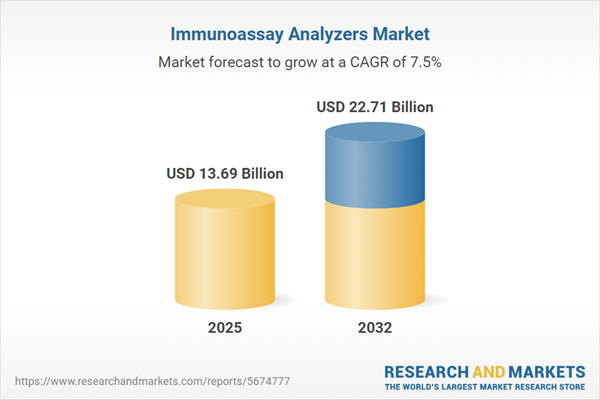Speak directly to the analyst to clarify any post sales queries you may have.
The immunoassay analyzers market is accelerating a new era of laboratory diagnostics, offering healthcare organizations increased efficiency, automation, and adaptability to evolving clinical needs.
Market Snapshot: Immunoassay Analyzers Market Overview
The global immunoassay analyzers market has reached USD 12.72 billion as of 2024 and is projected to achieve USD 13.69 billion in 2025 and USD 22.71 billion by 2032, with a steady CAGR of 7.51%. Growth is underpinned by significant investments in laboratory automation and rapid adoption of innovative diagnostic technologies. Healthcare systems throughout the Americas use modern immunoassay analyzers to streamline operational workflows and enhance overall service quality for diverse patient populations. In EMEA, modernization initiatives expand diagnostic service access and improve care delivery, while Asia-Pacific is emerging as a focal region with promising demand from both mature and developing markets. Immunoassay analyzers have emerged as vital assets, providing laboratories with the flexibility and scalability essential to thrive in an increasingly complex global healthcare environment.
Scope & Segmentation
- Technology: Includes chemiluminescence immunoassay, enzyme-linked immunosorbent assay (ELISA), fluorescence immunoassay, and radioimmunoassay. These technologies provide high sensitivity and can be integrated across laboratory automation platforms to address diverse diagnostic challenges.
- Product Type: Options span benchtop analyzers, multiplex analyzers, single module systems, fully automated floor-standing units, tabletop models, and semi-automated solutions, enabling laboratories to match infrastructure investments with varying throughput requirements.
- Application: Supports autoimmune disorder screening, cardiorespiratory biomarker analysis, hormone and thyroid assessments, infection detection, and oncology marker testing, empowering compliance with changeable clinical-care protocols.
- End User: Serves clinical laboratories, reference labs, specialty facilities, hospitals, ambulatory clinics, pharmacies, physician offices, and research centers, delivering operational flexibility and supporting scalable diagnostic services.
- Throughput: Platforms accommodate high, medium, and low sample volumes, providing responsive scaling to manage fluctuations in patient or research demands efficiently.
- Sample Type: Devices process plasma, serum, saliva, urine, and whole blood, offering the adaptability needed for robust laboratory operations serving diverse clinical and research needs.
- Region: Market coverage includes the Americas, Europe, Middle East, Africa, and Asia-Pacific, factoring in regional regulatory differences and distinct operating dynamics encompassing key geographies such as the United States, Germany, China, India, South Africa, and Brazil.
- Key Companies: Notable industry participants include F. Hoffmann-La Roche AG, Abbott Laboratories, Siemens Healthineers AG, Danaher Corporation, Thermo Fisher Scientific Inc., Ortho Clinical Diagnostics, bioMérieux SA, DiaSorin S.p.A., Bio-Rad Laboratories, and Mindray Medical International Limited. These organizations consistently influence technology standards and shape market adoption trends.
Key Takeaways: Strategic Insights for Senior Decision-Makers
- Automated immunoassay analyzer platforms integrate advanced software to improve diagnostic reliability and reduce reliance on labor-intensive manual procedures.
- Multiplex analyzers allow simultaneous testing for multiple biomarkers, helping laboratories stay agile in response to changing clinical guidelines and new diagnostic needs.
- Scalable modular architectures enable organizations to expand testing capacity efficiently with minimal disruption to workflow continuity.
- Shift toward decentralized and point-of-care testing is increasing patient access and accelerating turnaround of results, supporting timely intervention in outpatient settings.
- Partnerships between technology providers and research institutions are fostering the fast-track development of diagnostic assays in line with shifting regulatory expectations.
- Emphasis on localized manufacturing and supply chain adaptability helps sustain operations and safeguard inventory against global trade policy uncertainties or supply interruptions.
Tariff Impact: Navigating U.S. Trade Measures
Changes in U.S. tariff policies have increased import-related costs for immunoassay analyzers and their associated consumables. Stakeholders are responding by investing in local manufacturing expansion and adaptable supply chain models, supporting uninterrupted business operations in a shifting global trade landscape.
Methodology & Data Sources
This analysis draws from structured interviews with laboratory executives, thorough cross-validation against third-party datasets, and review of leading secondary data sources. The methodology delivers transparency and reliability, supporting confident decision-making for senior executives.
Why This Report Matters
- Senior leaders access actionable market segmentation and benchmarks to clarify investment decisions and strengthen compliance across global healthcare systems.
- The comprehensive structure supports strategic planning, market entry, and growth initiatives, while highlighting operational improvements suited to diverse regional needs.
- Laboratory managers and stakeholders receive guidance for sustaining agility while aligning processes to emerging diagnostic standards and evolving regulations.
Conclusion
Armed with timely market intelligence, healthcare decision-makers can advance strategic alignment, sustain high diagnostic performance, and optimize laboratory resources amid industry transformation.
Additional Product Information:
- Purchase of this report includes 1 year online access with quarterly updates.
- This report can be updated on request. Please contact our Customer Experience team using the Ask a Question widget on our website.
Table of Contents
3. Executive Summary
4. Market Overview
7. Cumulative Impact of Artificial Intelligence 2025
Companies Mentioned
The companies profiled in this Immunoassay Analyzers market report include:- F. Hoffmann-La Roche AG
- Abbott Laboratories
- Siemens Healthineers AG
- Danaher Corporation
- Thermo Fisher Scientific Inc.
- Ortho Clinical Diagnostics, Inc.
- bioMérieux SA
- DiaSorin S.p.A.
- Bio-Rad Laboratories, Inc.
- Mindray Medical International Limited
Table Information
| Report Attribute | Details |
|---|---|
| No. of Pages | 195 |
| Published | November 2025 |
| Forecast Period | 2025 - 2032 |
| Estimated Market Value ( USD | $ 13.69 Billion |
| Forecasted Market Value ( USD | $ 22.71 Billion |
| Compound Annual Growth Rate | 7.5% |
| Regions Covered | Global |
| No. of Companies Mentioned | 11 |









